2012 Mountain Sled Evaluations: Final Thoughts

What we liked and didn't in our fleet of 2012 powder sleds
One night during the 2013 Spring model evaluations, we reflected about what we learned about the new model year 2013 mountain and crossover snowmobiles as compared to the previous year’s versions. The improvements for 2013 are much welcomed. Even so, as we move to the 2013 model year, we look back fondly at the MY2012 deep powder models – Polaris’ RMK Pro 800 and 600 155; Arctic Cat’s M8 Sno Pro 153; Ski-Doo’s Summit X 154; and Yamaha’s Mountain Performance Inc. turbocharger-equipped Nytro MTX 162. They were killer rides. As we conclude the past snow season, we offer some final thoughts of our five long term 2012 mountain snowmobiles that we rode, yelled at, played on and tested in the western snows of 2011-2012.
Ski-Doo Summit X 154
The 154 XP Summit X’s 2.5-inch deep lug, 16-inch wide Powder Max II track was the track to beat in 2012. With its S-36 handling package, the Summit proved agile in the trees and compliant to ride. However, the XP had a tendency to “handlebar whip” when encountering dug-in trenches on hard-packed snow, and the chassis had a weak habit to run with its skis on the ground when initiating some sidehill attacks.
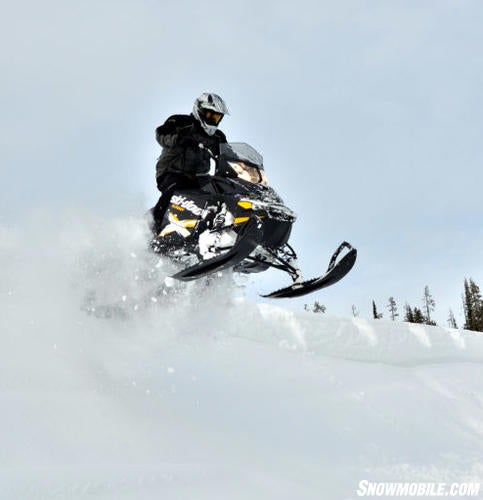 The 2012 XP Summit X was Snowmobile.com’s mountain snowmobile of the year. Its track and refined S-36 handling package made it a mountain stomper.
The 2012 XP Summit X was Snowmobile.com’s mountain snowmobile of the year. Its track and refined S-36 handling package made it a mountain stomper.To be fair though, the 2012 Summit X in deep powder was a stomper. It moved through the powder with ease and climbed with vicious intent. Here is where I give the 2012 Summit X huge “atta boys.” It had rear seat storage, a painted tunnel that kept snow from flash freezing to the tunnel, and a rear suspension that was not wishy-washy.
For 2013, the XM Summit X and SP are, well, I still haven’t found the words to describe my better-than-pleased attitude. Bottom line, the 2012 Summit X delivered what we expected and some expectations were good and some were traditional foibles. We liked the sled and can’t wait to be on the XM Summit for the upcoming 2013 season.
Test Rider Kevin Allred Adds
The 2012 Summit X came with a handful of improvements from 2011, ergo handlebars, rear seat storage, hotter motor calibrations, improved suspensions and a tall non-ported 2.5 Powder Max II track, which was phenomenal. I felt it was the best deep-snow performer.
The E-TEC engine was smooth and dependable packing a hard punch. In mid-range when trail riding, the motor provided excellent fuel economy, but in deep snow conditions, when wide open, fuel usage was slightly better than the other 800s; you have to burn the fuel to make horsepower.
The 2012 Summit’s ride in the rough was second to none; the suspension team at BRP did an incredible job. I usually found myself migrating towards the Summit for the ride back to the truck, as well as our other team riders. In a blanket statement, the 2012 Summit X was tough; we had no problems or warranty issues.
Polaris RMK Pro 800 155 and 600 155
The Snowmobile.com powder crew was often asked: “Isn’t the RMK Pro the best mountain snowmobile on the snow?” What matters is what you believe, not us. If you already believe this, why ask?
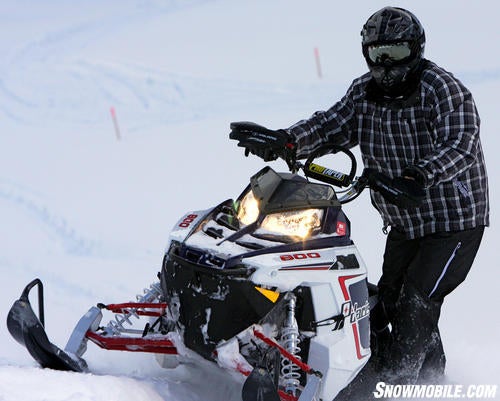 In its gorgeous TX retro finish the 800 RMK Pro was both a crowd pleaser and mountain killer.
In its gorgeous TX retro finish the 800 RMK Pro was both a crowd pleaser and mountain killer.The two Pros we had gave us the tools to be skilled technical backcountry riders. What we liked were the handlebars, seat and runningboards. The RMKs’ smooth lines kept them gliding along a sidehill when stuffed into it. The CleanFire motors were strong. I must add, the 600 RMK Pro was a sneaky, stealthy wondersled. Probably our favorite and most surprising snowmobile for 2012.
Test Rider Jake Allred Adds
The Pros are at home scoring high marks; if you have the guts to hang in to the top, these machines can defy gravity. In highly technical boondocking conditions, their balance is predictable where a rider can thread the needle. The Pros are so easy to ride that I found myself considering ridiculous lines. Even the downhill sidehill, which is commonly considered to be one of the more difficult maneuvers to articulate, was simple to pull off.
The Pros’ throttle pull was slightly heavier than I prefer, and they could benefit from a little less ski pressure. Though the footboards are incredibly good, snow still managed to accumulate on them, and I did lose my footing a couple of times. The Pro RMKs were two impressive sleds; these mountain sleds didn’t tip their hats to anything else out there.”
Test Rider Kevin Allred Adds
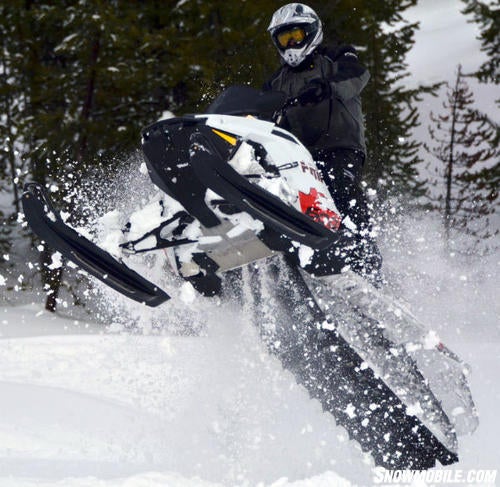 We tried and tried to find the 2012 RMK Pro 600’s weak spots. It hasn’t any. The “600” was returned with the most miles on it, because it had the most to prove. Here test rider Kevin Allred proves it can fly.
We tried and tried to find the 2012 RMK Pro 600’s weak spots. It hasn’t any. The “600” was returned with the most miles on it, because it had the most to prove. Here test rider Kevin Allred proves it can fly.My feelings about the 2012 Pros remain as from 2011 — I like them. What I want from a backcountry mountain sled can be found in the Pros. Apparently other mountain riders feel the same, as for the second year in a row it was the number one selling sled.
Our 2012 800 and 600 delivered flawless engine and drivetrain performance. They easily slipped on top of the snow to hang a sidehill like none else. I have a high level of confidence on these sleds in technical situations. For me, the Pros just work.
Pro riders need to educate themselves on ice scratcher use; this is essential since the Pro RMK comes without a front heat exchanger. We found in marginal or hard packed snow that ice scratchers were a must. Lastly, we experienced no problems or warranty issues.
Arctic Cat M8 Sno Pro 153
The ProClimb M8 in its first year experienced some growing pains coupled with an out-with-the old-and-in-with-the-new identity crisis. After 600 miles, the Snowmobile.com Mountain Team learned and appreciated that the 2012 ProClimb is a better sled than the 2011 M8.
The ProClimb handled rough terrain with ease when climbing busted up chutes. The Suzuki-built 800 was beefy with hefty torque. The cockpit is rider compliant and the telescopic handlebars allowed a driver to dial in the sled for attack modes.
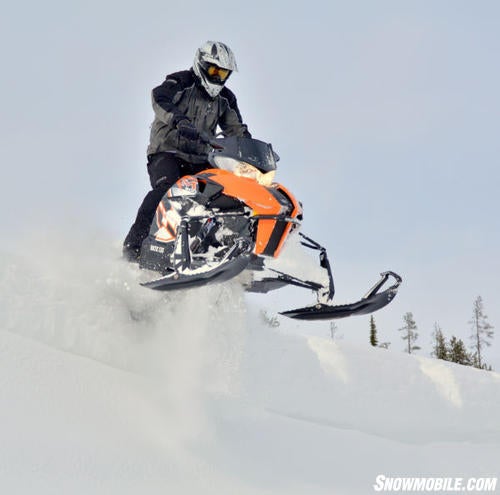 Test rider Kevin Allred found his youth launching the ProClimb M8 Sno Pro off a cornice. The MY2012 M8 proved robust with no warranty problems.
Test rider Kevin Allred found his youth launching the ProClimb M8 Sno Pro off a cornice. The MY2012 M8 proved robust with no warranty problems.For 2012, the steering ratio was off for technical maneuvering in tree-infested sidehills. The rear skid, in its mounting position, led the ProClimb M8 to trench where the 2011 did not. The seat, in my opinion, is too long, flat and wide. And in consensus by the Mountain Team, the skis are not powder skis at all. The M8’s blunt nose and underbelly didn’t allow it to smoothly glide through powder. Also, the tunnel’s rear end thawed and froze snow to the point the rear end could become an ice block.
None of these aforementioned quirks are beyond Cat to fix. We noted that for 2013, the M8 Sno Pro addresses some of these. This sled is evolving and growing. We have great hopes for this mountain sled, and implore Cat to waste no time in cleaning it up.
Test Rider Kevin Allred Adds
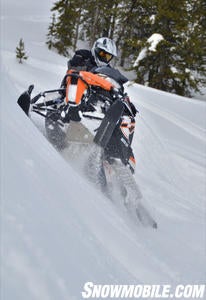 The 2012 M8 was stuffed into many hillsides where it held its line, but at times it did not, due to its off-ratio steering. MY2013 is improved with revised steering speed and ratio for sidehill attacks.
The 2012 M8 was stuffed into many hillsides where it held its line, but at times it did not, due to its off-ratio steering. MY2013 is improved with revised steering speed and ratio for sidehill attacks.This was the first year on the new ProClimb chassis, which shares common parts through Arctic’s line from race, trail to mountain; the same chassis accepts both the four- and two-stroke power. Arctic did a great job marrying the mountain necessities to this common chassis. The ProClimb shared from the 2011 M the proven 800cc HO motor and 2.25 Power Claw track.
I was at home on the new ProClimb; rider position felt right with the vertical steering and adjustable-height handlebars. Front-end geometry with tall spindles, combined with improvements to the rear skid, improved ride quality from the previous chassis. Backcountry handling was correct for serious sidehill conditions. It did, though, have off-steering that kept a rider from a high-siding a mountain. Most of my complaints are nixed now that we’ve seen and ridden the 2013.
We clocked over 600 miles on our M8 and experienced no mechanical problems. Other than a few first year hiccups, our experience with the next generation M8 was good.
Yamaha Nytro MTX 162 with MPI Turbocharger
The Nytro MTX likes boost. Its turbo power carried the 600-pound sled with ease and its turbo-specific track handled the amped-up power. The motor was as reliable as motors without a turbocharger. So hammer on and don’t be weak.
The Nytro MTX needs updating though. First, its runningboards are outdated; it needs storage; its steering post should mimic the Apex MTX or yesteryear — more vertical than horizontal; it needs more fuel storage; and it needs smoother sweeping lines at the belly pan and around the front suspension.
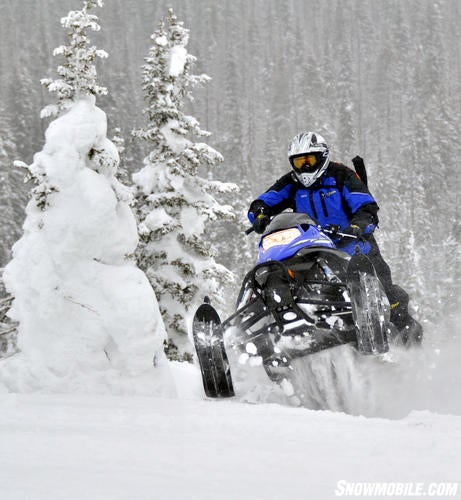 When the MPI turbo’s full boost comes home to play, the MTX Nytro, even at high altitudes, rolls on top the powder and makes the vehicle feathery light. However, as depicted from this head on shot, the Nytro MTX would benefit from some smoother belly pan lines.
When the MPI turbo’s full boost comes home to play, the MTX Nytro, even at high altitudes, rolls on top the powder and makes the vehicle feathery light. However, as depicted from this head on shot, the Nytro MTX would benefit from some smoother belly pan lines.The MTX has an allure that’s hard to define. Perhaps its differentness – to coin a phrase – casts a fondness for the snowmobile. In summation, it is nice to roll the key, squeeze the loud lever and go.
Test Rider Jake Allred Adds
My first experience with the Nytro turbo surprised me. One day, with approximately three-feet of fresh snow, and hills tall enough to stretch its legs and exercise the mechanical lungs of this mountain-bred machine, it snapped to life quicker than naturally aspirated stockers I rode that day – its strong torque made mountain pulls clean. With a conservative amount of boost, the turbo MTX was a force to reckon with. The 162-inch track is the ticket for its copious amounts of horsepower. The increased ballast in the engine is noticeable, but its extra wide skis kept the front afloat in the deep fluff.
The Nytro’s ergonomics are comfortable for standard mountain riding. The footboards are adequate in width, and no complaints are registered on the seat. The handlebars have an arcing stem rather than a vertical stem, which takes a little getting used to. It can be a bit of a handful in tight trees, but practice seems to minimize it. Turbo spool time was quick and lag was not an issue. The motor can definitely handle additional turbo boost for even more impressive heart pounding thrust.
Test Rider Kevin Allred Adds
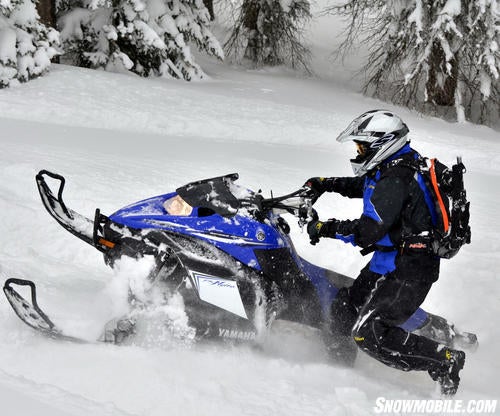 Yamaha’s turbocharged MTX with monster Ascent track lifts the chassis when the snow is light and deep.
Yamaha’s turbocharged MTX with monster Ascent track lifts the chassis when the snow is light and deep.We got a late start on our MTX while waiting for the MPI turbo to be installed. The 2012 Nytro came with the 15 X 162 X 2.25 Yamaha Ascent track, which is designed to handle the high horsepower. The MPI turbo is factory set at nine-pounds of boost building 175-plus horsepower. The boosted 1049cc fuel-injected three-cylinder motor, combined with the Assent track, makes for a very good climbing combination.
In April, we assembled our evaluation team for one last ride. Typical Spring riding conditions existed. I noticed the boosted Nytro MTX never sat still, someone was always pulling a hill. The sled is amazing fun on a hill in spring conditions.
Our 2012 Nytro MTX came with wide MT-9 skis that are parabolic. The ski worked well on the trail and in the deep snow, but I prefer the standard Yamaha powder ski, it provides better keel bite in the snow. Other than a factory assembly technical hitch of heat exchanger blockage in the tunnel heat exchanger, which restricted coolant flow, we experienced no problems with the Yamaha Nytro. In fact this was the first problem we ever experienced with any of our Yamahas.
Related Reading 2012 Mountain Sled Evaluations: Part 1 2012 Mountain Sled Evaluations: Part 2 First Impressions of the 2013 Powder Sleds 2012 Polaris 600 Pro-RMK 155 Review [Video] 2012 Polaris 800 Pro-RMK Review [Video] 2012 Ski-Doo Summit 800 Review [Video] 2012 Arctic Cat ProClimb M800 Review [Video] 2012 Yamaha Nytro MTX 162 “Boosted” Review [Video]




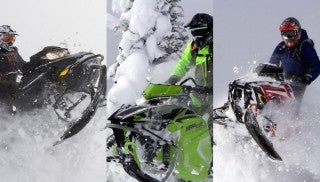
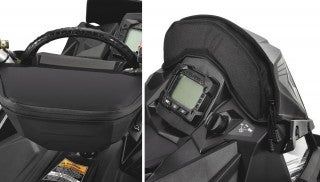


 Your Privacy Choices
Your Privacy Choices